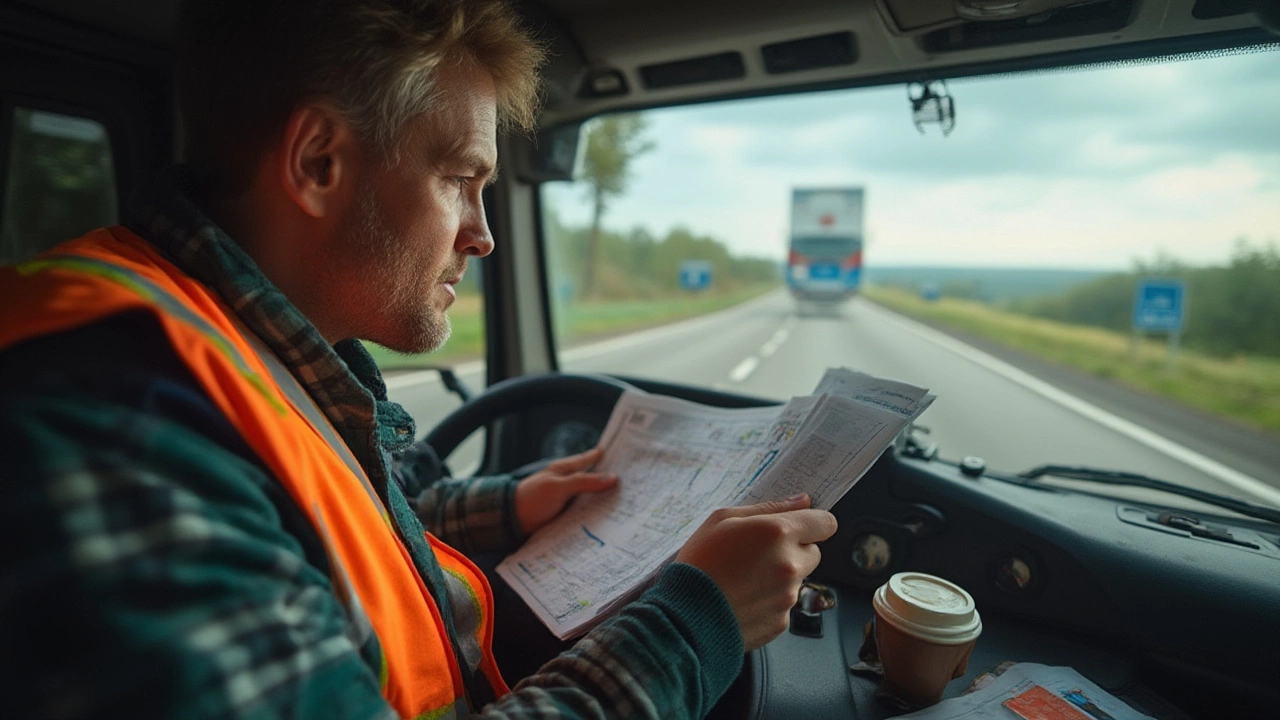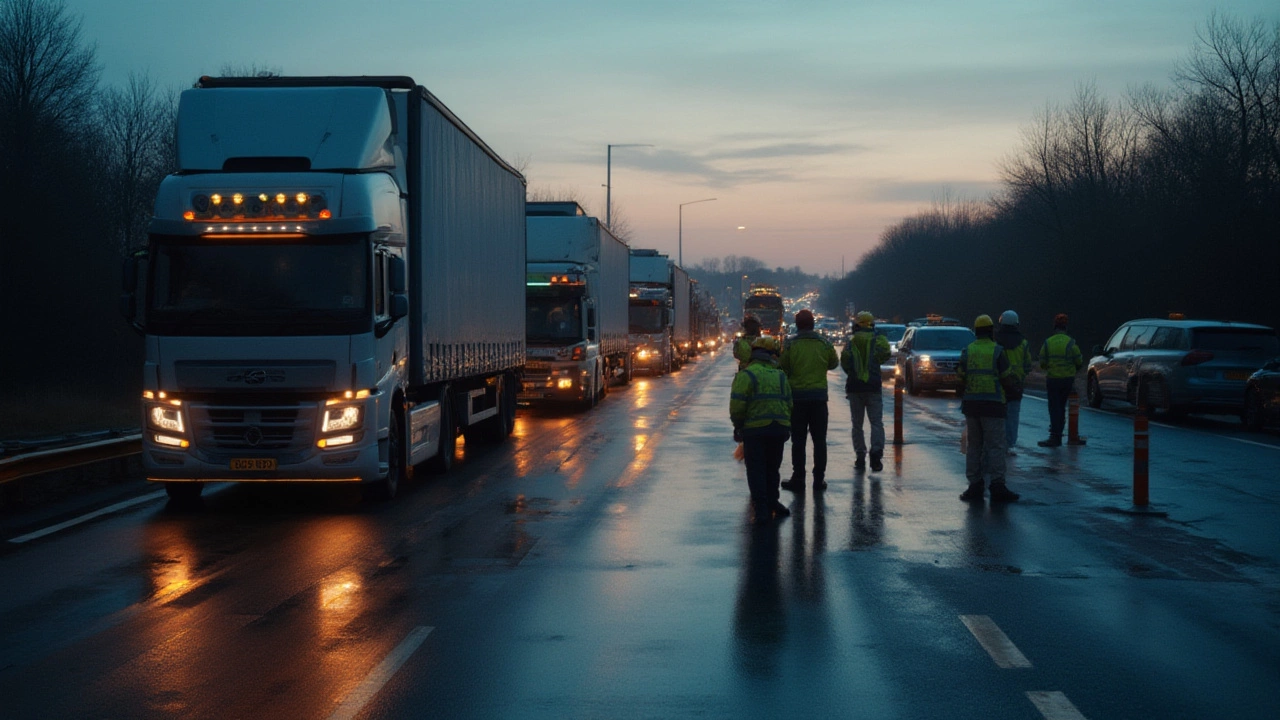Ever wondered what keeps Britain’s supermarkets, DIY stores, and favourite online shops so well-stocked? It’s not magic; it’s trunking. If you picture lorry drivers navigating endless city centre roundabouts, you might be surprised. Trunking driving swaps stressy city routes for long-haul, mostly motorway stretches—think fewer stops, bigger trucks, and crucial supply lines running from major distribution hubs. It’s simple on paper, but behind the scenes, trunking is the hidden engine in the logistics world. And lately, trunking driving jobs are in major demand, with companies desperate for reliable drivers to connect regional and national depots 24/7. Stick around and you’ll see why.
What is Trunking Driving and How Does It Work?
Let’s clear up the jargon first: trunking driving isn’t about the ‘trunk’ of your car—it comes from the term “truck trunk lines,” which in old telecoms and railways meant main routes linking big hubs. In trunking, drivers move large vehicles, often articulated lorries, between depots, warehouses, or regional centres. It’s a bit like being on the UK’s arterial roads: you’re the jugular vein keeping goods pumping from one end of the country to another, rather than dropping off milk at every small shop in town.
Most trunking is linehaul work—drivers collect loaded trailers at one big depot, drive mainly by motorway, and drop them at another big hub. Sometimes, it works like a relay race: a driver hauls a trailer part-way, meets a colleague coming the other direction, swaps trailers, then returns to base. No multi-storey car parks, no squeezing a 44-tonne lorry into a cul-de-sac; just big open yards and smoother, predictable journeys.
Day-to-day, trunking jobs might sound repetitive, but for lots of HGV drivers, that’s exactly the appeal. You know your route before you leave, you’re not battling city traffic every minute, and unloading is usually handled by warehouse staff. If you’re tired of making fifteen drops a day or waiting around offloading pallets at small retailers, trunking feels refreshingly efficient. There’s less physical graft since you’re mostly just swapping trailers instead of lumping heavy boxes.
Trunking is especially common with HGV Class 1 (Artic) vehicles, running between regional distribution centres for giant retailers like Amazon, Tesco or Aldi, or third-party logistics firms like DHL. Shifts can run day or night, seven days a week—you’ll often see trunking drivers heading out at 9pm, moving goods while the rest of us sleep, ensuring lorries can reach stores as soon as they open. Long stretches on the M1 or M6 become a way of life, and for many, the open motorway is where driving feels purest and most peaceful.
A big upside: regular hours. While multi-drop drivers face unpredictable stops and traffic snarls, trunking drivers often finish close to the planned time, clock off, then hand the keys over to the next shift. For anyone craving more work–life balance—and less time chasing delays—this is a godsend. In the UK, most major distribution networks live by trunking, running hubs overnight so goods flow non-stop. With post-pandemic e-commerce still booming, there’s a real shortage of experienced drivers, so trunking gigs are hardly going away any time soon.
Here’s a glance at some standard aspects of trunking:
- Routes: Usually between two main centres—rarely stopping at shops, homes, or city centre locations.
- Shifts: Day or night, sometimes rotating—some drivers alternate between a week of nights, then days, to keep the fleet moving non-stop.
- Loads: Pre-packed, usually by warehouse teams—you just hitch or unhitch trailers.
- Regulations: Must follow all HGV rules for tachographs, rest breaks, and maximum driving hours—most employers are strict on this.
- Technology: Sat navs, electronic logging, and high-tech comms are standard, but the job still hinges on your road sense.
- Pay: Often pays a bit more than multi-drop, especially for unsociable hours or overnight trunking runs.
Here’s a snapshot of the types of vehicles and runs you’ll get in trunking:
| HGV Class | Typical Run | Distance (Average Per Shift) | Common Employers |
|---|---|---|---|
| Class 1 Artic | Depot-to-depot | 150–400 miles | Major retailers, 3PLs (DHL, Wincanton) |
| Class 2 Rigid | Smaller regional hubs | 50–200 miles | Supermarkets, regional wholesalers |

Inside Trunking Life: The Pros, Cons and What You’ll Actually Do
If you ask most trunking drivers what they like about their work, you’ll hear the same things—no insane rush to load and unload, no endless city-centre drop-offs, no angry customers. Instead, it’s all about routine, reliability, and long, almost meditative hours on the motorways. That doesn't mean it's a walk in the park, though. The job comes with its unique challenges: lonely hours, strict timekeeping, and the ever-present question—can you stay alert behind the wheel for that fourth hour in the pitch-dark Midlands?
Trunking shifts can be early mornings, late nights, or even split shifts, depending how many vehicles a depot needs moving at once. Many drivers say night's best: fewer cars, faster journeys, and a peaceful road. The flipside? You might be sipping cold coffee at 2am in a rest stop off the M62, wishing you were home in bed. Day-shift trunkers tend to get more traffic, but at least you’re awake, and sunrise over the motorway is hard to beat.
One big draw is the chance to drive top-spec vehicles. Since the work is so central to logistics, fleets tend to keep their best lorries for trunking, with proper comfort cabs, adaptive cruise, and even in-cab entertainment system for rest breaks. Anyone who’s slogged round housing estates in a battered rigid will tell you that’s a serious perk.
Still, despite predictable routes, trunkers need strong concentration. It’s easy to zone out with the constant drone of the engine, so companies stress the need for discipline—plan your rest breaks, move around at rest stops, and keep snacks and water handy. A Department for Transport study from 2023 found that trunkers who neglect breaks are twice as likely to report micro-sleeps on shift. That’s scary, and a reminder that ‘just driving’ isn’t as easy as it sounds.
Let’s break down some of the actual daily routines:
- Arrive at the depot, check paperwork, grab keys, and check the truck (lights, tyres, brakes).
- Collect your assigned trailer—sometimes hooking yourself, other times swapping with another driver.
- Log your route and set up your digital tacho.
- Hit the road, joining the motorway (A-roads if you’re unlucky), aiming for efficiency, not speed.
- Stop at a service station for required breaks, stretch legs and grab a bite—often timing your stops to avoid peak traffic.
- Arrive at the end depot, drop the trailer, file paperwork, and either swap trailers or head back empty (known as ‘backloading’).
What about the pay? Trunking can edge ahead of other HGV work, especially if you pick up overnight or Sunday rates. According to Logistics UK’s June 2024 pay report, median trunking pay in England is £16.50–£21 an hour, rising above £25/hour for experienced drivers on night trunking runs during Christmas peak. Many companies now give loyalty bonuses if you stick around—driver retention is always a struggle.
Any downsides? Well, monotony tops the list. Without the variety of multi-drops or driving new routes, the days can blur together. Isolation can be tough, too, especially for new drivers used to social jobs. Podcasts, audiobooks, and radio help, plus most trunkers join online groups to swap advice and share road gossip. The big one, though, is strict hours—miss your delivery slot by even ten minutes and you might be in the hot seat with your ops manager. That means always knowing your route, watching for delays, and calling ahead if you hit a jam.
It’s not a job for everyone, but if you love driving, hate constant interruptions, and enjoy a work rhythm you can pretty much set your watch by, trunking is about as steady as HGV life gets. Plenty of drivers do it for years, moving up to shift supervisor or even transport manager roles when they’re done clocking up motorway miles.
Quick stats snapshot:
| Fact | Figure |
|---|---|
| Average Shift Length | 8–11 hours |
| Breakdown rate (per 100k miles) | 0.12 |
| Top Employer (UK) | Tesco |
| Peak Trunking Season | October–December (retail & holidays) |
| Most Common Route | Birmingham–Manchester–Leeds triangle |

Tips for Getting Into Trunking and Thriving on the Road
Thinking about a move into trunking? Here’s where to start. First, you need the right license—almost every trunking gig requires a Class 1 (C+E), which lets you drive articulated HGVs. Some big regional trunking work can be done with a Class 2, but the lion’s share is artics. If you haven’t got your HGV yet, think about doing your test with a focus on trunking routes—practice motorways, long runs, and depot procedures, not just urban driving.
Once qualified, agency work is a solid way to break in. Agencies fill gaps in supermarket and parcel trunk fleets year-round, snapping up new drivers for weekend shifts and covering summer or Christmas peaks. This gives you a feel for routes, shifts, and big-fleet systems without committing to one employer just yet. Keep your paperwork sharp—driver CPC, medical, and tacho card are non-negotiable—and be ready to show experience, even if it’s just training runs. Many depots offer driver mentor shadowing for a week, letting you settle in before tackling a solo trunk.
Want to get ahead? Here are a few real-life tips from drivers who’ve made the leap:
- Learn your depot layouts fast. Every minute wasted looking for the right trailer or queueing for the weighbridge eats into your rest time.
- Master in-cab tech, especially digital tachographs—mistakes cost you hours when you’re just trying to get home.
- Bring comfort gear: memory-foam seat cushion, polarised sunglasses for dawn runs, and decent food for long stretches without a break.
- Sort your playlist or audiobook library—there are drivers who’ve clocked the whole Game of Thrones saga on night trunking shifts.
- Get to know service area facilities—some are miles better than others. Ask regulars about hidden gems with great showers or parking.
- Stay alert to changing rest regulations—these do change, usually every spring or autumn, and the fines for getting them wrong are savage.
- Protect your sleep. Block out light in your cab, invest in ear plugs, and avoid hardcore energy drinks unless you want the inevitable crash later.
- Most important: never underestimate motorway boredom. Take proactive micro-breaks, eat light, and keep a log of how you’re feeling—tiredness creeps up when you least expect it.
After a while, you’ll find your rhythm, and maybe even get a shot at advanced driving training or promotion. The best trunking drivers earn respect for reliability, safe records, and ultra-smooth handovers. Learn from the veterans—they’ll tell you tales of snow runs in Scotland, midnight detours through Wales, and the best cafe breakfasts on the A1. That’s the difference with trunking—you’re not just a cog but the main artery in UK logistics, trusted to get the nation’s goods safely home every night.
So next time someone mentions trunking and you picture tree trunks or elephants, remember the real heroes—drivers working the night trunk lines. Not glamorous, maybe, but try running Christmas without them. It just wouldn’t happen.

